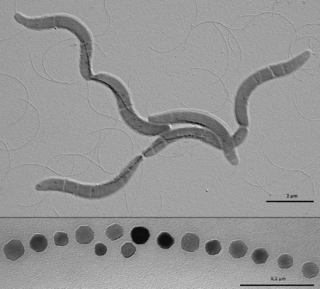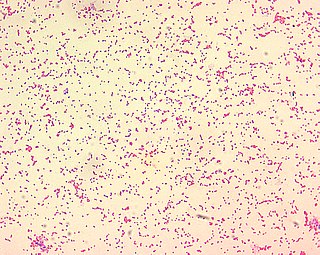Related Research Articles

Enterococcus is a large genus of lactic acid bacteria of the phylum Firmicutes. Enterococci are gram-positive cocci that often occur in pairs (diplococci) or short chains, and are difficult to distinguish from streptococci on physical characteristics alone. Two species are common commensal organisms in the intestines of humans: E. faecalis (90–95%) and E. faecium (5–10%). Rare clusters of infections occur with other species, including E. casseliflavus, E. gallinarum, and E. raffinosus.

The Rhodospirillales are an order of Proteobacteria.

The Brucellaceae are a family of the Gram-negative Hyphomicrobiales. They are named after Sir David Bruce, a Scottish microbiologist. They are aerobic chemoorganotrophes. The family comprises pathogen and soil bacteria

Archaeoglobaceae are a family of the Archaeoglobales. All known genera within the Archaeoglobaceae are hyperthermophilic and can be found near undersea hydrothermal vents. Archaeoglobaceae are the only family in the order Archaeoglobales, which is the only order in the class Archaeoglobi.

Haemophilus is a genus of Gram-negative, pleomorphic, coccobacilli bacteria belonging to the family Pasteurellaceae. While Haemophilus bacteria are typically small coccobacilli, they are categorized as pleomorphic bacteria because of the wide range of shapes they occasionally assume. These organisms inhabit the mucous membranes of the upper respiratory tract, mouth, vagina, and intestinal tract. The genus includes commensal organisms along with some significant pathogenic species such as H. influenzae—a cause of sepsis and bacterial meningitis in young children—and H. ducreyi, the causative agent of chancroid. All members are either aerobic or facultatively anaerobic. This genus has been found to be part of the salivary microbiome.
In taxonomy, the Halobacteriaceae are a family of the Halobacteriales in the domain Archaea. Halobacteriaceae represent a large part of halophilic Archaea, along with members in two other methanogenic families, Methanosarcinaceae and Methanocalculaceae. The family consists of many diverse genera that can survive extreme environmental niches. Most commonly, Halobacteriaceae are found in hypersaline lakes and can even tolerate sites polluted by heavy metals. They include neutrophiles, acidophiles, alkaliphiles, and there have even been psychrotolerant species discovered. Some members have been known to live aerobically, as well as anaerobically, and they come in many different morphologies. These diverse morphologies include rods in genus Halobacterium, cocci in Halococcus, flattened discs or cups in Haloferax, and other shapes ranging from flattened triangles in Haloarcula to squares in Haloquadratum, and Natronorubrum. Most species of Halobacteriaceae are best known for their high salt tolerance and red-pink pigmented members, but there are also non-pigmented species and those that require moderate salt conditions. Some species of Halobacteriaceae have been shown to exhibit phosphorus solubilizing activities that contribute to phosphorus cycling in hypersaline environments. Techniques such as 16S rRNA analysis and DNA-DNA hybridization have been major contributors to taxonomic classification in Halobacteriaceae, partly due to the difficulty in culturing halophilic Archaea.
In taxonomy, the Thermoplasmata are a class of the Euryarchaeota.
In taxonomy, the Thermoplasmatales are an order of the Thermoplasmata. All are acidophiles, growing optimally at pH below 2. Picrophilus is currently the most acidophilic of all known organisms, being capable of growing at a pH of -0.06. Many of these organisms do not contain a cell wall, although this is not true in the case of Picrophilus. Most members of the Thermotoplasmata are thermophilic.

Canada is a country in North America. Its ten provinces and three territories extend from the Atlantic to the Pacific and northward into the Arctic Ocean, covering 9.98 million square kilometres, making it the world's second-largest country by total area. Its southern and western border with the United States, stretching 8,891 kilometres (5,525 mi), is the world's longest bi-national land border. Canada's capital is Ottawa, and its three largest metropolitan areas are Toronto, Montreal, and Vancouver.

In the taxonomy of microorganisms, the Methanomicrobia are a class of the Euryarchaeota.
Rhodomicrobium is a microaerobic to anaerobic, purple non-sulfur, cluster-building genus of bacteria. Rhodomicrobium uses bacteriochlorophyll a and bacteriochlorophyll b for photosynthesis and occurs in fresh- and sea-water and in soil
Streptomyces abikoensis is a bacterium species from the genus of Streptomyces which produces the antibiotic abikoviromycin. Streptomyces abikoensis has been isolated from Abiko in Japan.
Ancylobacter is a genus of aerobic bacteria from the family of Xanthobacteraceae.
The Lachnospiraceae are a family of obligately anaerobic, variably spore-forming bacteria in the order Clostridiales that ferment diverse plant polysaccharides to short-chain fatty acids and alcohols (ethanol). These bacteria are among the most abundant taxa in the rumen and the human gut microbiota. Members of this family may protect against colon cancer in humans by producing butyric acid. Lachnospiraceae have been found to contribute to diabetes in genetically susceptible (ob/ob) germ-free mice.
Asaia is a genus of Gram-negative, aerobic and rod-shaped bacteria from the family of Acetobacteraceae which occur in tropical plants. Asaia might be able to control malaria by massively colonizing the midgut and the male reproductive system of the mosquito Anopheles stephensi
Colwellia is a genus of deep-sea psychrophilic, piezophilic, and facultative anaerobic bacteria from the family Colwelliaceae. Colwellia grows at a temperature at −20 °C by producing cryoprotective polymeric substances.
Caminibacter is a genus of anaerobic and thermophilic bacteria from the family Nautiliaceae.
Methylocystis is a genus of bacteria from the family Methylocystaceae.
Geobacillus is a bacterial genus from the family of Bacillaceae.
Jeotgalibacillus is a Gram-positive bacterial genus from the family Planococcaceae.